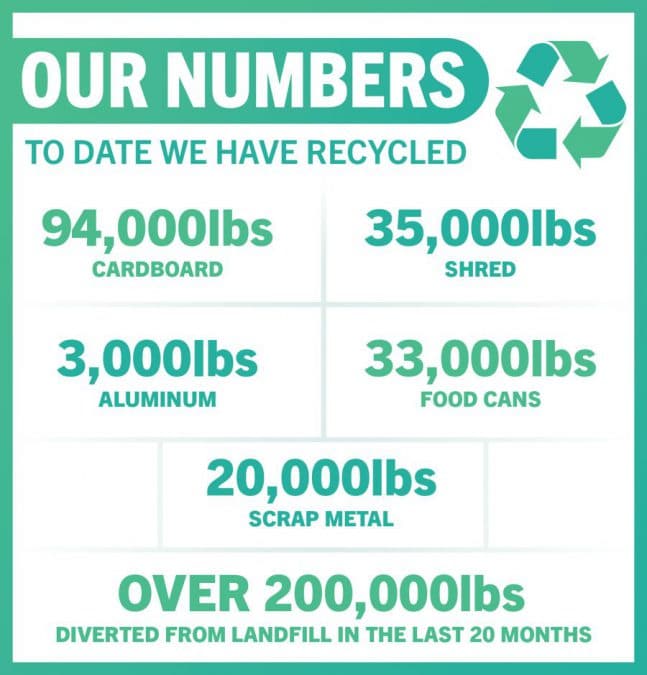By Holliann Burnett, Public Information Intern
Most people are familiar with the recycling bins sitting near the end of the curbs in their communities. Some view recycling as a hassle, where others see it as a duty. Wherever one stands, recycling benefits the planet, provides jobs and even helps businesses save money. However, China’s 2017 restrictions on what recyclables they will import from the United States have made recycling efforts more complicated in recent years. Citizen Potawatomi Nation Environmental Sustainability Specialist Jeff Tompkins oversees CPN’s recycling program and strives to keep it a priority for Tribal enterprises.
According to the United States Environmental Protection Agency, around 75 percent of what Americans throw away is recyclable, but only about 30 percent of it is actually recycled. With numerous enterprises employing more than 2,200 people, CPN produces no shortage of trash.
Tompkins understands the importance of recycling. In March 2017 when he came on board, the preliminary stages of the recycling program already existed. He began with re-implementing “Green Team” meetings with managers and directors of different enterprises at CPN to generate plans for the materials they threw away. Eventually, he met the directors of housing and maintenance. With the help of the staff from these departments, they began dispersing recycling bins around CPN’s businesses and collecting materials.
“I believe CPN is such a large industry with so many different departments and enterprises, that what we are doing now is just scratching the surface of what we are capable of (recycling),” Tompkins said.
CPN currently accepts cardboard, paper shred, aluminum and steel cans internally. Materials such as glass, plastic foam and other plastics are still recycled in a slightly different process. These items must be placed in a clear, plastic sack and put in the green recycling bins outside of each department for an outside company to pick up.
“Roughly over the last 20 months, the Tribe has collected over 200,000 pounds of material, not only diverting it from the landfill but also turning it into a profit,” Tompkins said.
A potential growth sector

Tompkins continues to learn and gain new ideas for the Tribe’s recycling program. At a training conference in Tulsa, Oklahoma, he spoke to a man who began borrowing his parents’ van on weekends to collect and sell old clothes and shoes. He maximized his profits by splitting them into three groups. The first group consists of clothes that can be washed, sanitized and reused. Clothes that can be cut up and used for products such as shop rags make up the second group. The last group includes clothes that can be ground down to be reprocessed into new clothing.
During this time, he also set up a clothing drive at a high school to raise funds for students who could not afford an upcoming trip to Disney World. The drive lasted one week, and after seeing advertisements and flyers, the community brought over 90,000 pounds of clothes. When sold, he made enough to support the school’s trip and pay his personnel who helped with the event. His business now operates in three warehouses, has a fleet of 13 trucks and employs a little over 30 people.
Tompkins noted this example to show that there are always new and innovative ways to recycle, and he hopes to one day bring these ideas to life at CPN. He identified numerous areas that may be able to save funds for the Nation or turn a profit. He found that businesses similar to CPN’s size have waste bills of up to $400,000 per year. He believes a healthy recycling program could reduce that cost by at least 10 percent, saving the Tribe $40,000 per year.
“Many industries pay to have their confidential documents destroyed, which is something that an industry our size would pay $50,000 to $60,000 a year for. Being able to do that internally would benefit the environment as well as CPN financially,” Tompkins said.
Inspiring future generations
CPN understands the importance of engaging beyond its own enterprises and into the community. During large events such as the Family Reunion Festival, the hashtag #CPNRecycles becomes popular on Facebook. Tompkins believes it is crucial to engage the younger generation so they can be educated about recycling and its benefits and maintain those standards into adulthood. The “selfie challenge” engages a wide audience by prompting everyone to take a selfie photograph while recycling an item into one of the Tribe’s recycling bins. They then use the hashtag #CPNRecycles and post it to the CPN Facebook page, which enters those who followed the steps into a contest to win a prize.
“Social media is a good platform to spread awareness and get a wider audience involved with recycling. We have had huge success from utilizing these platforms,” Tompkins said.
Tompkins laid out some practical ways to get involved with recycling right here at CPN or any community. Two beginning concepts for everyone include: educating yourself on the environmental and financial benefits of recycling as well as buying reusable goods. For those at CPN, learning the location of the recycling containers and putting them to use is a great step. Familiarization with the site and methods of transporting materials to the recycling facility can assist as well. Whether Tribal member or not, every person can do their part to help protect the environment.
For more information on recycling at CPN, visit cpn.news/cpnoeh.
